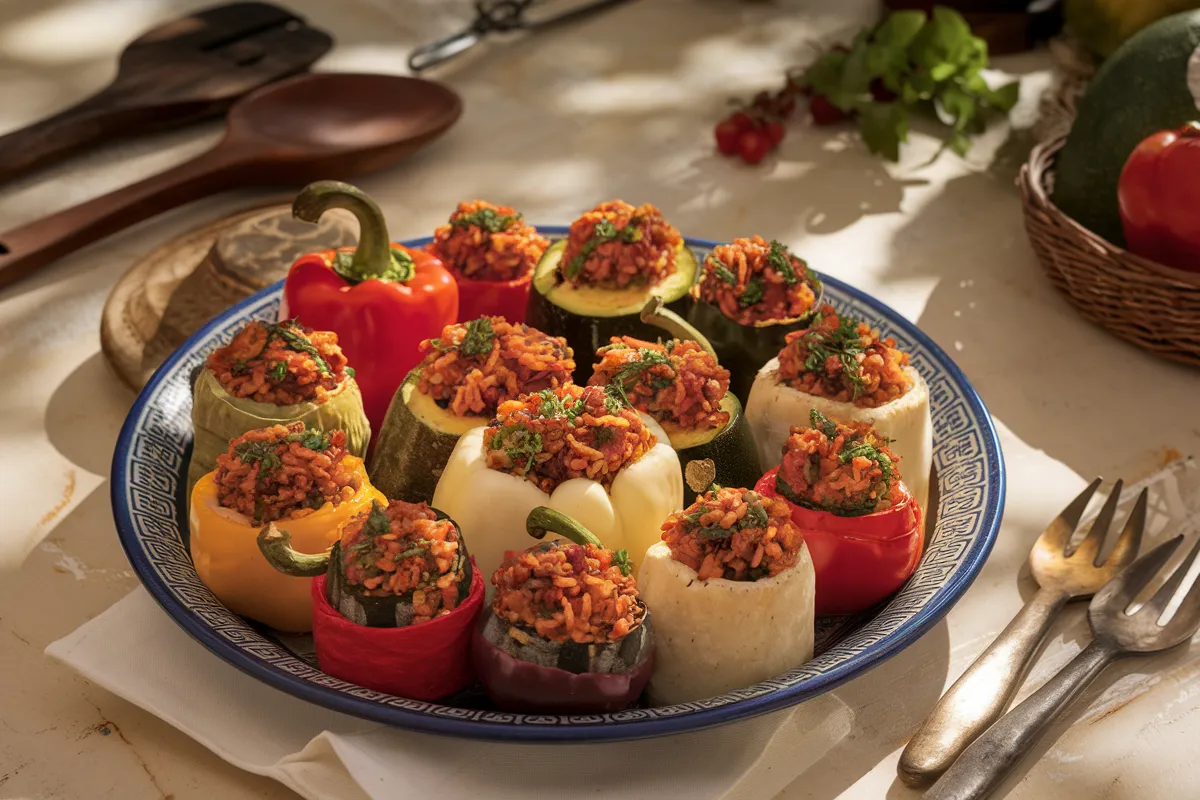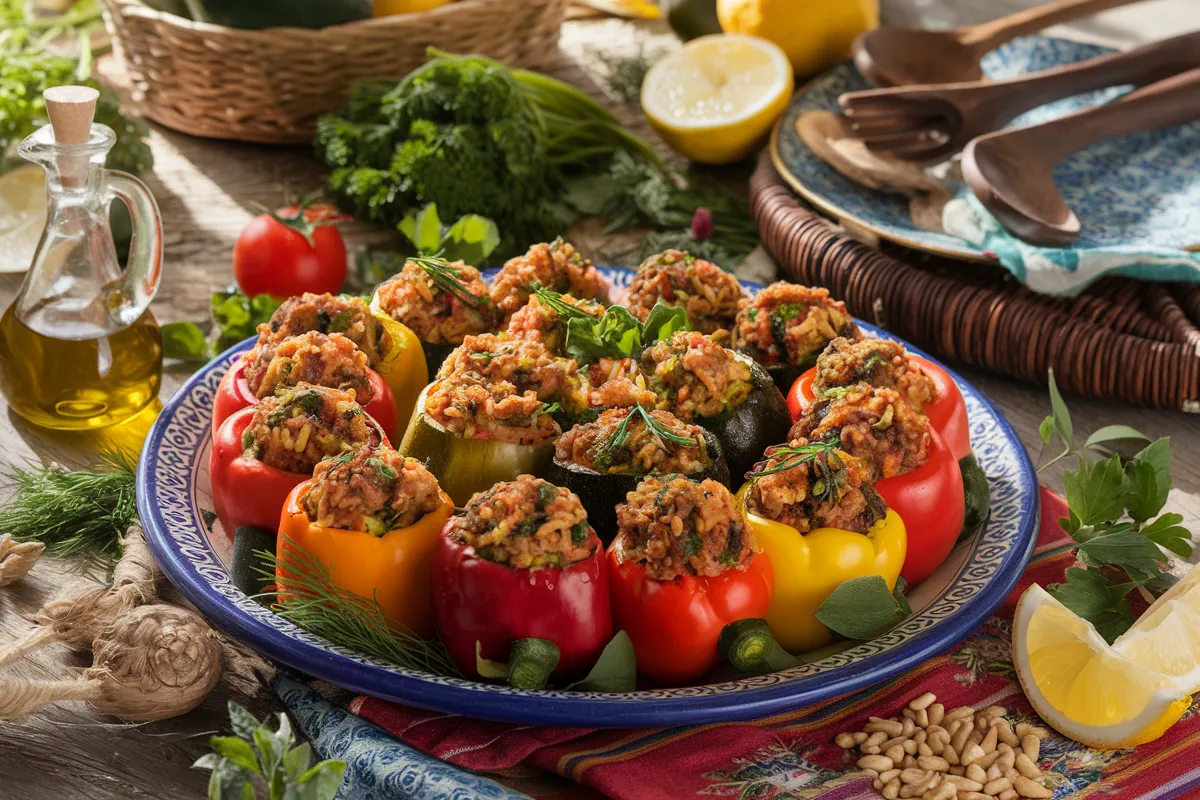When you explore the rich tapestry of Turkish cuisine, Dolma emerges as a must-try dish. This traditional dish of Turkish stuffed vegetables showcases a variety of flavors, blending rice, meat, pine nuts, and spices within vegetables like bell peppers, tomatoes, and eggplants. Dolma has a long history, tracing back to the Ottoman Empire, and has influenced many other cultures across the Mediterranean and Middle East.
Origins of Dolma: A Deep Dive into Turkish Stuffed Vegetables
Dolma, a cornerstone of Turkish cuisine, means “stuffed” in Turkish, and it refers to the technique of filling vegetables with a savory mixture. This dish gained popularity in the Ottoman Empire and spread throughout the regions under Ottoman influence, including the Balkans, Greece, and the Middle East.
The dish’s versatility has led to countless variations, making Dolma a staple in many households. The traditional preparation involves stuffing vegetables such as bell peppers, zucchini, and eggplants with a blend of rice, spices, and sometimes meat, creating a satisfying meal. Learn more about the rich history of Dolma and its cultural impact by visiting this comprehensive resource on Dolma.
Dolma’s Role in Ottoman Cuisine
In the grand kitchens of the Ottoman Empire, Dolma was a dish fit for royalty, often served during lavish feasts. Over time, it became a beloved dish across the empire, with each region adapting the recipe to include local ingredients and flavors. For example, Greek Dolmades use grape leaves, while Armenian Tolma often features cabbage leaves.
If you’re looking to try your hand at making a traditional version of this dish, this Authentic Turkish Dolma Recipe is a great place to start.
Variations of Turkish Stuffed Vegetables
Dolma is incredibly versatile, with many variations across Turkey and beyond. Here are some popular types of Turkish stuffed vegetables:
Classic Vegetable Dolma
The most traditional form of Dolma involves stuffing vegetables such as bell peppers, tomatoes, zucchini, and eggplants. This type of Dolma is a staple in Turkish households and is often served as part of a larger meal. For a creative take on a similar dish, check out this recipe for Stuffed Eggplant: Vegetarian, Delicious, and Healthy Recipes.
Sweet Fruit Dolma
Less common but just as delightful, Fruit Dolma involves stuffing fruits like apples or quinces with a mixture of nuts, dried fruits, and spices. This version is often served as a dessert or during special occasions, highlighting the versatility of Turkish stuffed vegetables.
Meat and Vegetarian Dolma
Dolma can be prepared with either a meat-based or vegetarian filling. Meat Dolma typically includes minced lamb or beef mixed with rice and spices, resulting in a hearty dish. Vegetarian Dolma focuses on the natural flavors of fresh herbs and vegetables, making it a lighter but equally flavorful option.
To explore more about stuffed vegetables, you might enjoy this article on Mediterranean Stuffed Zucchini, which offers a delightful Mediterranean twist on the traditional Turkish dish.
Ingredients and Regional Differences in Turkish Stuffed Vegetables
The ingredients in Dolma can vary widely depending on the region and specific recipe, but some elements are consistent across most versions of this Turkish stuffed vegetable dish.
Common Ingredients in Dolma
- Rice: A staple in most Dolma recipes, providing a neutral base that absorbs the flavors of the other ingredients.
- Pine Nuts and Currants: These add texture and a touch of sweetness, especially in vegetarian Dolma.
- Herbs: Fresh parsley, dill, and mint are essential for the aromatic profile of Dolma.
- Spices: Allspice, cinnamon, and black pepper are commonly used to add warmth and complexity.
- Olive Oil: A key component in Turkish cooking, used both in the filling and during the cooking process.
Regional Variations of Turkish Stuffed Vegetables
Different regions of Turkey have developed their own unique takes on Dolma. For instance, in the Aegean region, Dolma is often prepared with a citrusy flavor, incorporating lemon juice, while in Anatolia, the dish tends to be heartier, often including meat and a robust spice profile.
For a closer look at how regional differences influence Turkish cuisine, particularly with eggplants, you might find this article on Turkish Stuffed Eggplant insightful.

How to Make Dolma: A Guide to Turkish Stuffed Vegetables
Preparing Dolma at home can be a rewarding experience. Here’s a step-by-step guide to making this traditional Turkish stuffed vegetable dish.
Step-by-Step Guide to Turkish Stuffed Vegetables
1. Prepare Your Vegetables
Select vegetables such as bell peppers, tomatoes, zucchini, and eggplants. Wash them thoroughly and hollow them out carefully to avoid piercing the skin. If you’re using grape or cabbage leaves, blanch them in boiling water to soften them.
For tips on working with eggplants, consider reading about Why Soak Eggplant in Water Before Cooking.
2. Create the Filling for Turkish Stuffed Vegetables
Cook finely chopped onions in olive oil until soft, then add rice and cook until lightly toasted. Stir in spices such as allspice, cinnamon, and black pepper. Add pine nuts, currants, and fresh herbs like parsley, dill, and mint. If preparing a meat-based Dolma, add minced lamb or beef at this stage and cook until browned.
3. Stuff and Cook the Vegetables
Using a small spoon, fill each vegetable with the mixture, leaving a little space at the top to allow for expansion during cooking. Arrange the stuffed vegetables in a pot, packing them tightly to prevent them from falling apart. Pour a mixture of water, olive oil, and lemon juice over the Dolma, enough to cover them halfway, and cook on low heat until tender.
4. Serve Turkish Stuffed Vegetables
Dolma can be served hot or cold, traditionally accompanied by yogurt and lemon wedges. It can be part of a larger meal or enjoyed on its own as a satisfying main course.
Health Benefits of Turkish Stuffed Vegetables
Dolma is not just delicious but also nutritious. This Turkish stuffed vegetable dish is rich in vitamins, minerals, and antioxidants, making it a healthy option for any diet.
Nutritional Value of Turkish Stuffed Vegetables
- Vegetables: Rich in vitamins A and C, and fiber, essential for maintaining good health.
- Olive Oil: Provides heart-healthy monounsaturated fats, important for cardiovascular health.
- Herbs and Spices: Packed with antioxidants that support overall well-being.
- Rice and Nuts: Offer essential nutrients like magnesium and iron, contributing to a balanced diet.
Incorporating Turkish Stuffed Vegetables into a Balanced Diet
Dolma fits well into a balanced diet, especially when made with fresh, whole ingredients. Whether you choose a meat or vegetarian filling, Dolma provides a nutritious and satisfying meal that supports a healthy lifestyle.
Cultural Significance of Turkish Stuffed Vegetables
Dolma is deeply rooted in Turkish culture, often prepared for special occasions, family gatherings, and religious holidays. It is a dish that symbolizes hospitality and togetherness, reflecting the values of Turkish society.
Dolma in Turkish Celebrations
Dolma is a common dish at Turkish weddings, served as part of a lavish feast. It is also a staple during Ramadan, included in the iftar meal. The preparation of Dolma is often a communal activity, with family members gathering to create this beloved dish.
The Symbolism of Turkish Stuffed Vegetables
In Turkish culture, Dolma represents more than just a meal; it is a symbol of family, tradition, and community. The act of making Dolma together strengthens family bonds and passes down cultural traditions from one generation to the next.
For more insights into the cultural significance of stuffed vegetable dishes, particularly with eggplants, see this article on Turkish Stuffed Eggplant.
FAQs About Turkish Stuffed Vegetables
- What’s the difference between Dolma and Sarma?
- Dolma generally refers to stuffed vegetables, while Sarma involves wrapping grape or cabbage leaves around the filling.
- Can Dolma be made vegan?
- Yes, many traditional Dolma recipes are naturally vegan, using rice, herbs, and vegetables as the primary ingredients.
- How do you store and reheat Dolma?
- Dolma can be stored in the refrigerator for up to three days. To reheat, gently warm them in a covered pot with a bit of water.
- Is Dolma served hot or cold?
- Dolma can be served either hot or cold, depending on the type and personal preference.
- What are the most common fillings used in Dolma?
- The most common fillings include rice, minced meat, pine nuts, currants, and a variety of herbs and spices.
Conclusion: Embracing the Richness of Turkish Stuffed Vegetables
Dolma is more than just a dish; it’s a reflection of Turkey’s rich culinary heritage. This traditional Turkish stuffed vegetable dish offers a blend of flavors, textures, and cultural significance that is truly unique. Whether you make it with meat or as a vegetarian dish, Dolma is sure to impress at any meal.
So, why not try making Dolma at home? With its rich history and delicious taste, it’s a dish that brings people together and offers a true taste of Turkish culture.

